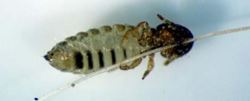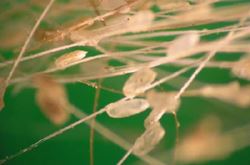|
Cold Weather Is Louse Weather
DR. LEE TOWNSEND
LEXINGTON, KY.
Cold weather is louse weather. Inadequate nutrition, compromised immune response, and shipping stress also favor outbreaks, if there are any infested animals in the herd. Additionally, fewer daylight hours during winter appear to contribute to problems with lice.
Spread and potential problems
Biting and sucking lice have been associated with reduced weight gains and general lack of thriftiness during periods of greatest winter stress. These small external parasites can spread quickly through a herd as animals bunch for warmth or when feeding.
The energy that biting and sucking lice “steal” can be costly, especially when coupled with other factors. Potential problems include loss of condition, increased susceptibility to or slow recovery from diseases, and generally poor performance. Blood feeding by large numbers of sucking lice can cause anemia. The combined stress of lice and intestinal worms can cause even larger problems.
What to look for
Investigate animals that show signs of excessive rubbing and loss of hair clumps. Raw spots develop from constant attempts to groom or scratch areas where lice are abundant. However, there are some other possible causes (ringworm, dietary deficiencies, mange, etc.). A careful examination of animals will let you identify the problem, or combination of problems correctly.
Infestations by some lice have a signature appearance. A “greasy” appearance due to crushed lice, their feces, blood, and serum from wounds point to the short-nosed cattle louse . Little blue cattle lice tend to settle around the eyes producing a goggle-like appearance. Feeding by biting lice produces a skin reaction in which the hair becomes loose. Eggs of the biting louse are laid on fine hairs and the coat takes on a matted appearance. While other factors can cause restlessness and scratching, a positive louse diagnosis can be confirmed or eliminated relatively quickly by checking the hide of animals with suspicious symptoms.

Figure 1. Biting louse gripping a strand of hair; note the wide, flat head.

Figure 2. Louse eggs (nits) glued to hairs.
Photos Lee Townsend, UK
Monitoring lice numbers
Light infestations of these external parasites are easy to overlook unless animals are inspected carefully. When louse numbers are low, they are usually limited to preferred spots. Examine five, 1-inch square areas on the face, dewlap, neck, back and base of the tail. Look first for nits (Figure 2), and then part the hair carefully to look for lice. Both biting and sucking lice feed head down with their abdomens pointed out. Identify the species present and estimate the number found per square inch at each site: counts of less than 5-very slight, 5 to 10-slight, 10 to 20-moderate, 20 to 50-severe, and more than 50-very severe.
In severe infestations, sucking lice are densely packed, creating characteristic quarter-sized black or blue-brown spots. They are reluctant to move, even when disturbed by skin searches. Biting lice, on the other hand, apparently do not like to be crowded so they are usually not found in tightly packed clusters. They are active and will move readily if disturbed.
Short- and long-term management
Insecticides
Depending on the situation, dewormers or insecticides provide quick knockdown of active infestations. Longer term practices ultimately can be incorporated into an integrated louse control program. A single application of any one of many systemic dewormers, such as doramectin, eprinomectin, ivomectin, or moxidectin, provides long term louse control for cattle. However, a winter application may trigger an adverse host-parasite reaction if the animals were not treated in fall to control cattle grubs.
A variety of contact (non-systemic) insecticides with active ingredients such as cyhalothrin, cyfluthrin, or permethrin provide good control of lice. They are sold in a variety of formulations (pour-ons, spot-ons, or dusts) that can be applied during cold weather. Dust bags or back rubbers may be used to dispense these products, as well.
Even if insecticide coverage on the animal is not thorough, there should be sufficient to knock down heavy infestations in order to reduce stress on the animals. Contact insecticides do not kill nits so a follow-up treatment is needed to control lice that emerge from eggs after the residual effect of the insecticide is lost. The insecticide label will tell you how long to wait before applying the second treatment. Any animals that are not treated will rekindle the infestation.
Integrated management
Long term integrated management of lice includes combinations of the following methods as practical:
• Cull reservoirs or carriers – Lice persist over the summer months on a small number of chronically infested reservoir animals. The parasites are transferred to other animals in the fall and winter. It is difficult to detect reservoir animals but they may be older, have compromised immune systems, or reduced ability to groom. General physical attributes can come into play. For example, the longer, thicker hair, and massive neck and shoulders of bulls makes self-grooming, which can reduce louse numbers, difficult.
• Nutrition – A high-energy ration seems to modify the effects of lice on weight gains, perhaps because lice populations decline on better-fed animals. Therefore, a sound feeding program and high energy ration serves as the foundation of a louse control program.
• Sanitation of premises – Live louse and nit transfer could occur from hair left on fences, truck rails, or bedding. Sucking lice usually die after just a few hours off the host but biting lice can survive for several days under ideal conditions. A clean-up and insecticide application to facilities used by infested animals, or by observing a 10 day interval before introducing new stock, will minimize the chances of carryover.
• Quarantine – In enterprises where animals move in and out of the inventory on a regular basis, it is best to assume that all incoming animals are infested. They should be isolated until their full course of treatment is completed.
• Repair fencing – Cross-fence contact can be sufficient for spread of these insects, especially during the winter when louse burdens are greatest.
• Effective biting fly control program – Lice on reservoir animals may be suppressed during the summer by treatments applied to protect animals from biting flies and ticks. ∆
DR. LEE TOWNSEND: Extension Entomologist, University of Kentucky
|
|